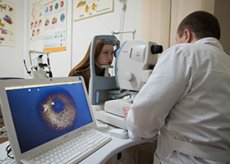Medical expert of the article
New publications
Structural studies in glaucoma
Last reviewed: 23.04.2024

All iLive content is medically reviewed or fact checked to ensure as much factual accuracy as possible.
We have strict sourcing guidelines and only link to reputable media sites, academic research institutions and, whenever possible, medically peer reviewed studies. Note that the numbers in parentheses ([1], [2], etc.) are clickable links to these studies.
If you feel that any of our content is inaccurate, out-of-date, or otherwise questionable, please select it and press Ctrl + Enter.

Glaucoma parameters are measured by evaluating the excavation of the optic nerve disk, the defects of the SNV and, possibly, the ratio of their thickness in the macula. These parameters are reliable signs of glaucoma and its progression.
The development of non-invasive objective methods for the study of the most prone to glaucomatous damage to the retinal structures facilitates the diagnosis and tracking of the progressive changes in glaucoma in the dynamics. Among the simplest techniques for assessing structural glaucomatous lesions - stereoscopic photography and photographing of strategic offensive arms. At the present time, new computerized visualizing analytical programs have been developed for more objective and quantitative measurements of the retinal SNV and optic nerve disc.
Photographing
Stereoscopic photographing of the optic nerve disc is one of the most widely used imaging techniques. Photographing strategic offensive weapons is more complex and less commonly used than photographing the optic nerve disk. The method allows for a broader assessment of strategic offensive arms during the examination of the patient. Specific changes in the retina in glaucoma include focal and diffuse thinning of SNV.
How do stereoscopic photography
Stereo images are obtained by continuous (sequential) or synchronous photography techniques. With continuous stereoscopic photography, two consecutive images are captured by manually moving the camera joystick. In synchronized stereoscopic photography, instantaneous stereo images are captured with one-time processing and the production of a folded of two photographs into one image or two 35 mm slides, depending on the system used.
When a stereoscopic photograph is used
Stereoscopic photographing of the optic nerve disc should be used with the availability of the method every 1 or 2 years to assess the condition of patients with suspected glaucoma and glaucoma to control the progression of the disease.
Restrictions
In the method of stereoscopic photographing of the optic disc, there is no objective system for interpreting the state of the optic nerve.
How to photograph a layer of nerve fibers
SNV consists of axons of ganglion cells, neuroglia and astrocytes. Collected together axons of ganglion cells are directed to the optic nerve. It is best to define START under red, blue or green light. The wavelength of the blue and green ranges is well absorbed by retinal pigment epithelium and choroid, and the axon bundles reflect light and appear as silver lines.
When photographing a layer of nerve fibers
The study of strategic offensive weapons is used to differentiate the suspicion of glaucoma and damage developing with true glaucoma. Defects of START precede the appearance of changes in the disk of the optic nerve and the field of vision. Thus, when the state of START is correlated with the field of view, subjective features detected with automatic perimetry are objectively confirmed.
Restrictions
Factors that limit the possibility of assessing START photos include haze of the environment, for example, cataracts, poorly focused photographs and poor contrast due to insufficient pigmentation of the fundus.


 [
[